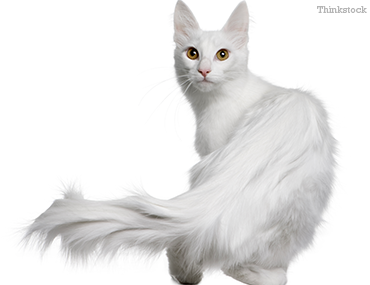Background:
The Turkish Angora is a breed of domestic cat and is one of the most ancient natural breeds. Originating in the Ankara region of Turkey, which was historically known as Angora, this breed had been documented as early as the 1600s and is often referred to as the Angora or Ankara cat.
Cat Facts:
- The Angora usually has a white coat but sometimes comes in patterns including tortoiseshell, tabby, and calico.

- The Angora is the ballerina of cats, having not only gracefulness but also strength.
- The Angora weighs between five and nine pounds and can live to be up to thirteen or more years old.
- Don’t panic: the longhaired Angora is not the source of angora sweaters; despite his beautifully silky coat.
What's the Turkish Angora like?
The Turkish Angora is very outgoing and will get along with nearly everyone -- even dogs! The Angora will quickly learn your routines and follow you everywhere. They love to climb so don’t be surprised to find them on top of your refrigerator.
This breed is definitely a family cat.
Typically they’re a healthy cat; however, Turkish Angoras with a white coat and blue eyes are prone to deafness. Some Angoras could develop a heart condition called hypertrophic cardiomyopathy: the most common form of heart disease in cats.
Takeaway Points:
- Turkish Angoras can be a very attention demanding cat because of how active they are. You may need to train this cat a bit because, like dogs, Angoras can pick up bad habits that can be hard to shake.
- Because of the Turkish Angora’s silky coat, grooming them is easy requiring only a weekly combing. If your Angora is white you may want to give him a bath every couple of months.
- If you have allergies, this cat can make them worse because they produce dander (although no cat breed is better or worse for people with allergies).
If you have any questions or concerns, you should always visit or call your veterinarian -- they are your best resource to ensure the health and well-being of your pets.
![]()

